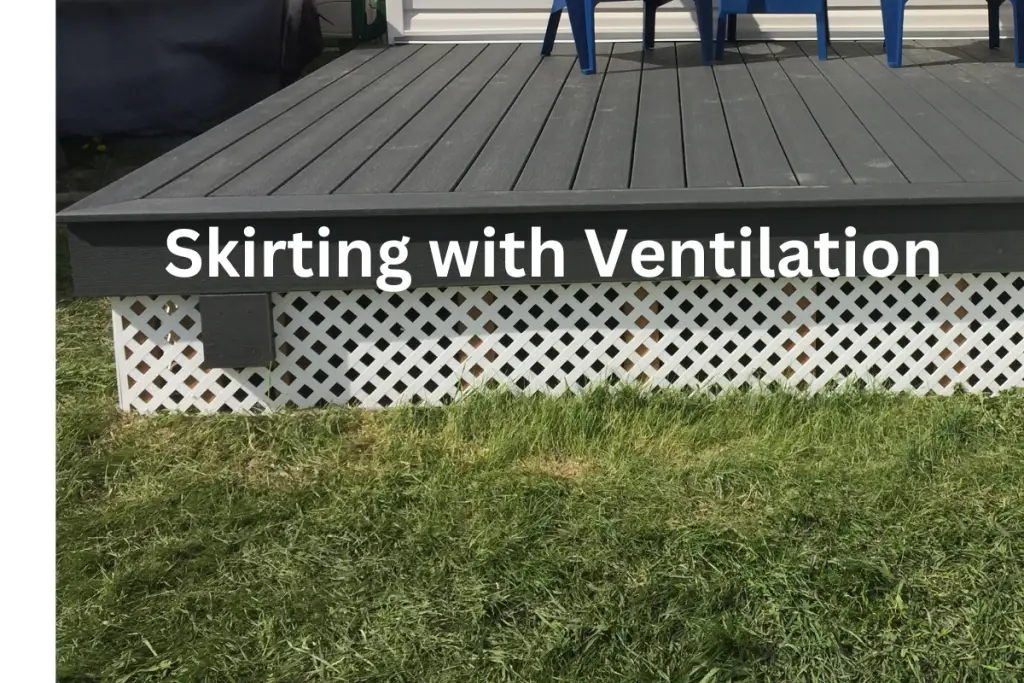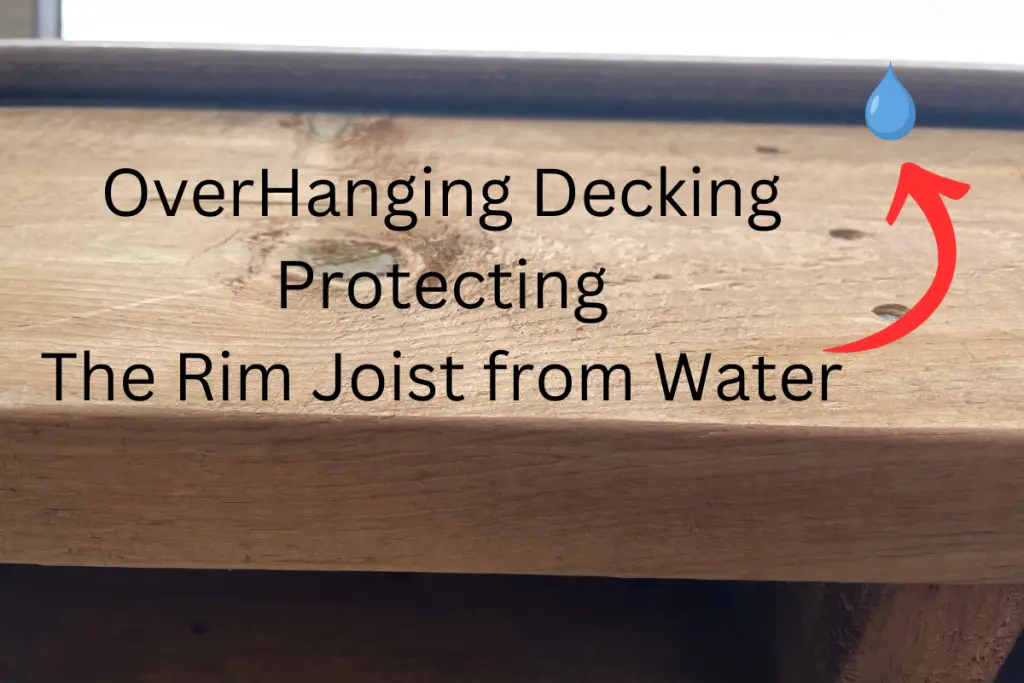The number one reason why a deck will need to be rebuilt or repaired is joist rot.
Preventing the joist from rotting will make a world of difference to how long you will get to enjoy your deck.
The surest way to protect your deck joists from rotting is to reduce the moisture level of the wood. Keeping moisture levels below 18% prevents fungi growth and joist rot. Ensuring your deck joists will remain strong and sturdy for many years.
Moisture is the number one killer of deck joists, but there are other elements that can be managed to prevent joists from rotting.
- Moisture
- Substrate (Food)
- Oxygen
- Fungi Infection
- Suitable Temperature
But moisture is by far the easiest to manage. This is why it is the biggest focus on preventing joist rot.
How To Prevent Joist from Rotting?
After years of building decks, I have tried and learned of many different ways, but let’s start with my 3 favourite tips for preventing rot.
Under Deck Ventilation
A good way to tackle moisture under your deck’s substructure is with good ventilation .
.
Simply by allowing fresh air to move freely underneath your deck, you can reduce the chances of rot destroying your joists as this will help any moisture or trapped water to dry up, giving rot-causing fungi less time to germinate.
This can be a simple as leaving tiny gaps between the skirting and rim joists (these only need to be ¾ of an inch wide).

Or include air vents (grills) in your skirting design. For every 150 square feet of deck, you need a minimum of 1 square foot vent. Ideally, one on each side to allow cross-wind air movement.
For many lower decks, less than 12″ above grade, no skirting may be a better idea. Unless rodents are a concern, then “open” skirting-like lattice that allows moisture to escape is a good option.
Joist Tape
Applied over the top of the joists, the flashing membrane shields the wood from water. The membrane protects the joist by sealing the penetrating screw holes. Keeping the water out of the joist.
We go more in-depth about the importance of joist tape in another article. Answering about how joists tape works and why it’s necessary for decks. Click the link to learn more.
for decks. Click the link to learn more.

Treat End Cuts
Pressure-treated wood is only surface treated. By treating all cuts with end-cut-treatment, you ensure that none of the wood is editable for fungi.
Beyond these three, if your deck is especially prone to rot, here are a few more ways to stop joist rot.
Seal the Joist with a Water Repellant Sealer
Pressure-treated wood is usually treated to fend off fungi and insects, not water. Sealing joists with a waterproof sealer also increases resistance against rot by repelling moisture from the lumber. Impeding rot. By keeping the wood below 18% of moisture content, for fungi cannot live.
Redirect Water Off the Deck Joists
Often the best solution is prevention. Constructing your deck in a way that moisture doesn’t get trapped, causing damage.
Take a page from The Karate Kid — the best form of defence is prevention. By diverting water away from your deck’s essential areas, you can avert countless problems before they start.

Below are 4 ways to redirect water off the joists.
- Overhang the Decking past the rim and fascia board to prevent water from being trapped.
- Slope Joist between 1/8” and 1/32” over a foot will allow water to run off the joist.
- Flash the ledger and beam prevents water from being trapped behind the material, decreasing rot.
- Remove Protruding Railing Posts. The post fastened to the rim joist traps moisture.
Beyond redirecting water, there are ways to minimize fungi growth.
Minimize Organic Material Building Up on Deck Joist
Gapping deck boards a minimum of 1/4″ not only allows rain to run off the decking but also minimizes gunk build-up between deck boards which harbour fungi rotting the top of the joists.

Don’t Face Screw Decking
There are many ways of doing this, from Camo to hidden fasteners, but the point is to hold down the edge of the decking. Minimizing cupping of the decking and removing dirt from building up on the screw heads.
to hidden fasteners, but the point is to hold down the edge of the decking. Minimizing cupping of the decking and removing dirt from building up on the screw heads.
Under Deck Drainage Systems
A rubberized membrane draped between and over the joist carries water away from the joists. Keeping them dry from the rain.

Reducing moisture under your deck will greatly help to stop joist rot. Remove the water, save the wood. Another approach to reducing fungi growth on deck joists is by treating the wood.
This can be done by.
Use a Higher Treatment Level for Joists.
Non-ground contact wood is only treated to 0.25-PCF, but ground contact wood is treated to 0.40-PCF. Using Ground contact wood, even in raised deck application, will minimize rot.
Treat Joist with Anti-freeze
Add a little warm water and boric acid solution to the anti-freeze and brush or roll it over your joist. Making the joist inedible for fungi.
Install Landscape Fabric Under the Deck Joist to Minimizing Contamination From Soil
Keeping the soil down and away from the joist will prevent fungi from growing on the wood.
Note: Do not be tempted to use plastic instead of landscape fabric. Plastic will only help water to remain stagnant and stay trapped underneath your deck rather than escaping.
Scalloped Composite Deck Boards
Scalloping the underside of composite decking is often done to reduce costs. So this is not an official recommendation but something to be considered.
Scallop boards have less contact with the joists with smaller contact points. Which reduces the area under the decking where water can become trapped.
The small channels under the decking also allow air to dry out the top of the joists. Like ventilation for the underside of the decking.
Not official, but could it help protect your joists while saving you money on your decking?
Conclusion of Stop Deck Joist from Rotting
Protecting your deck joists from water is essential for preserving the life of your deck. Beyond ventilation, using flashing tape, and treating ends with end-cut treatment will be the most effective way to prevent your joists from rotting.
But you can do even more by redirecting water away from vulnerable areas. Preventing trapping moisture causing rot.
Additionally, treating wood with anti-freeze or higher levels of treatment can help prevent rot as well.
Along with landscape fabric under low decks, the most vulnerable to rot will prevent contamination.
With these tips in mind, while you build your next deck, you should be able to successfully prevent your joists from rotting due to moisture and keep them strong for years to come!
Enjoy your deck.
